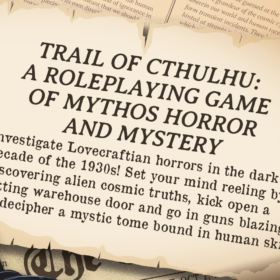See Page XX
See Page XX: Making Structure Organic
When we elect to play RPGs in story-driven mode, we have an array of different narrative forms to draw inspiration from. All of them, from drama to fiction to comic books and movies, offer different lessons. Like magpies, we can steal the most applicable ideas and techniques from each form. By synthesizing these with techniques uniquely necessary for the RPG experience, we can develop a common GMing repertoire.
The key is knowing which elements to swipe, and which to leave behind.
For example, I’d avoid attempts to impose a rigorous act structure on an RPG session or campaign. Hollywood movie screenplays supposedly follow a rigid three-act structure. Films written to this model are allegedly more likely to be hits, and are definitely more likely to sell to producers. In this model, popularized by the screenplay manual writer Syd Field, the first act establishes a situation and puts it into motion. At the first act break, which should appear as close to page 20 of the screenplay as possible, a new event comes into play, which irrevocably alters the protagonist’s core situation. (Screenplays generally time out to one minute per page.) The second act break occurs about twenty to thirty minutes before the end of the film. Again an irrevocable twist on the main situation occurs, which raises the stakes and leads the characters inexorably to the climax, resolution, and denouement.
I’d argue that blind adherence to this act structure leads to disappointing results in its original medium, let alone roleplaying. It tends to lead to a static or meandering second act, which serves as a holding pattern until the final act break occurs to throw the story into high gear. The “low point” for the protagonist that is now supposed to accompany this act break has become so commonplace in blockbusters as to become a predictable cliché. Once you learn to spot it, its rote audience manipulation becomes glaringly apparent.
While some great films can be broken down according to this structure, just as many ignore it entirely. As the screenwriter Todd Alcott demonstrates the structural analyses he performs on his highly recommended Livejournal, it’s not only art house fare that ignores the three-act structure. Mass popcorn favorites like Raiders Of the Lost Ark employ more complex structures, arising organically from the needs of their own stories. Spielberg in general tends to choose (or shape) four-act structures.
Ironically, Syd Field himself, in his seminal book Screenplay, predicts the coming obsolescence of the three-act structure, in favor of a set-piece style as epitomized by the films of Stanley Kubrick. Then his book was taken up by a manual by producers, discouraging the very evolution he predicted.
Where commercial screenplays are carefully shaped to install the narrative turns in exactly the right place, roleplaying campaigns and sessions are improvised. They occur in the moment, like first drafts. They’re collaborative, so that no one author, not even the GM, should know for sure where they’re going. (Though it never hurts to have a vague idea to fall back on.) As such, you never know where you are in the story as a whole.
What you do know is where you stand relative to the narrative beats that have already occurred. That’s why, in studying narratives in other forms, I prefer to focus on the relationship of adjacent scenes than on the bigger structure they fit into. Work to achieve contrasting rhythms within sequences and the structure will take care of itself.
Where structure, or the lack thereof, is concerned, television seasons and comic book story arcs are better models than the screenplay. In each case, the final installments are being written after the first ones have already reached the public. As a result, they tolerate a greater degree of raggedness and can be more digressive than film scripts. They pick up and drop elements. Not everything the writers set up is finally paid off.
On TV, individual episodes may include multiple storylines. A problem-solving A-story may be set up, developed and wrapped up in a single episode. Alongside it, a continuity-furthering B-story might further a sub-plot which was established in a previous episode and will be resolved in a later one—if at all. On some shows, a discrete season follows an overall arc, setting up a situation in episode one and bringing it to a head during the finale. Sometimes the arc itself is a broader A-story lending a semblance of coherence when what really matters is the rewardingly meandering character development. Most seasons of The Sopranos seem to be defined by new mob antagonists for Tony, but in the end the show is about his nuclear family, not Richie Aprile or Phil Leotardo. The Wire introduces a new institutional element to its socio-political examination of Baltimore each season, but follows its characters in a sprawling, novelistic fashion.
Following these models frees you to be collaborative and reactive. You can let the players take their characters where they want to follow. Without pushing them to a particular turning point at a predetermined moment, you nonetheless ensue that each individual session maintains its own inner tension.
As you do this, you’ll occasionally find that climactic moments present themselves. Suddenly it will appear before your eyes — a way to knit together a host of disparate plot threads so that it all seemed like it fit into a structure all along.
Because a roleplaying is a jointly-authored first draft, with the GM and players and the dice and rules system all pulling it in various directions, structure is not something you impose beforehand. It’s something that appears to have happened in retrospect.


